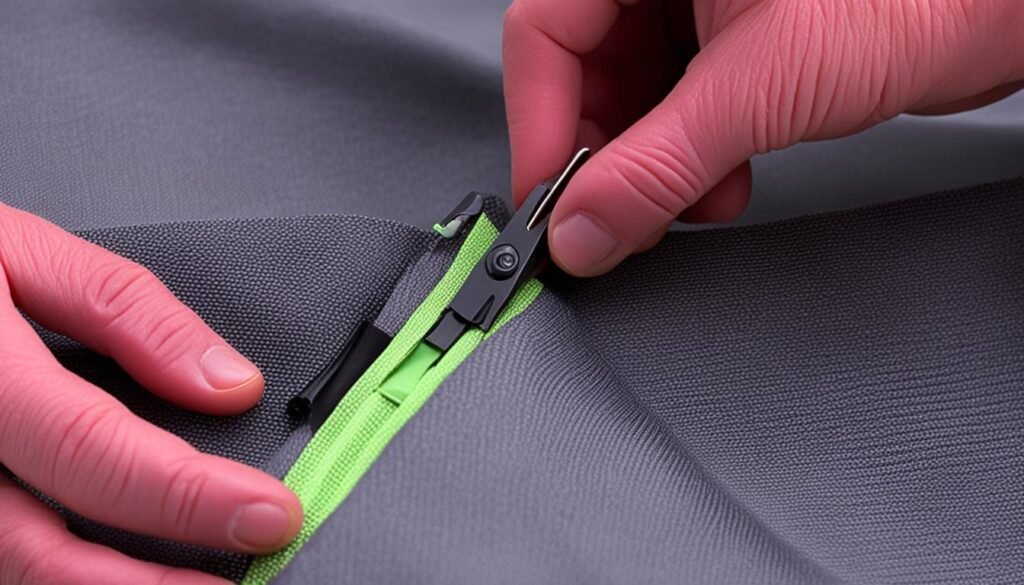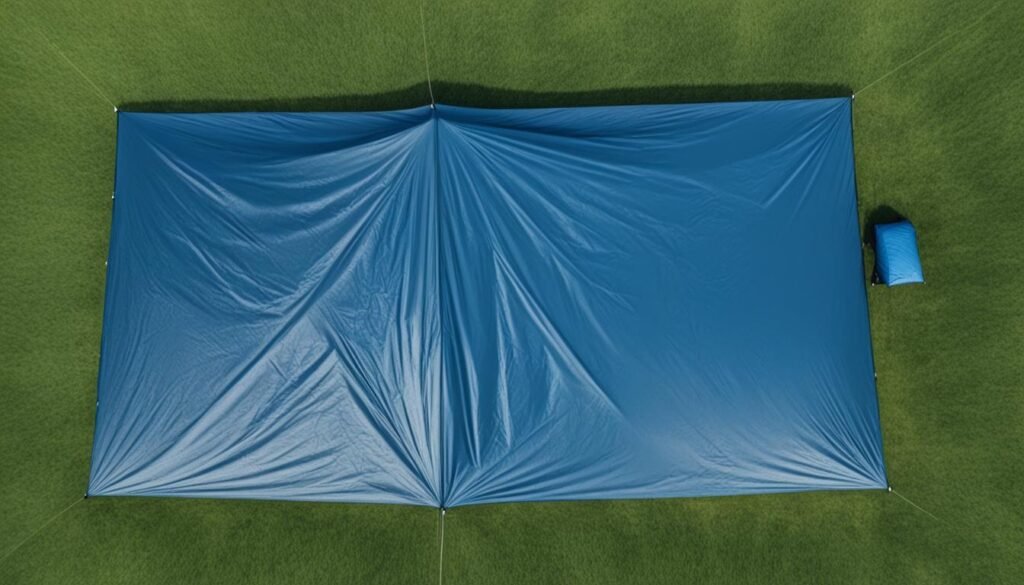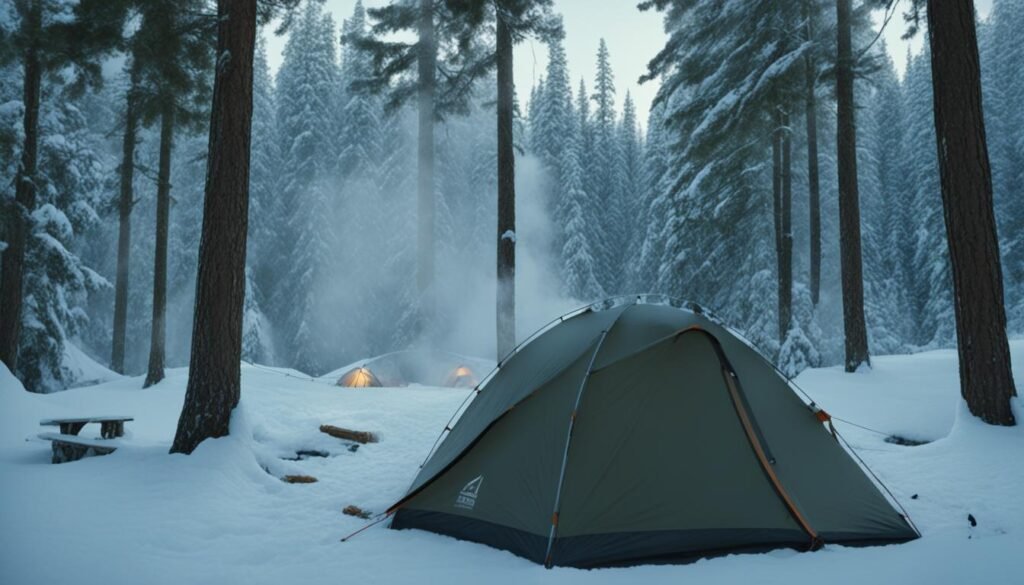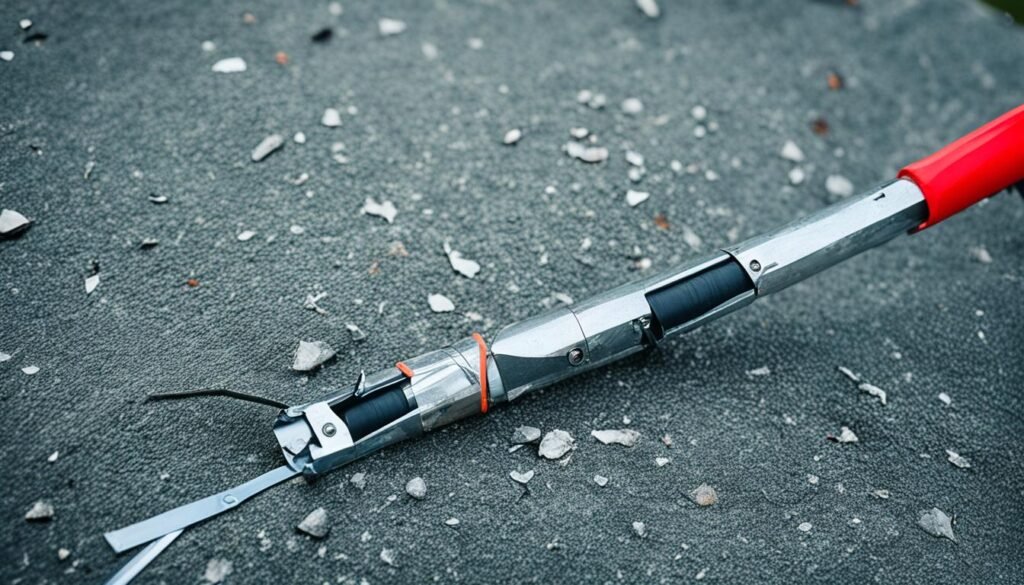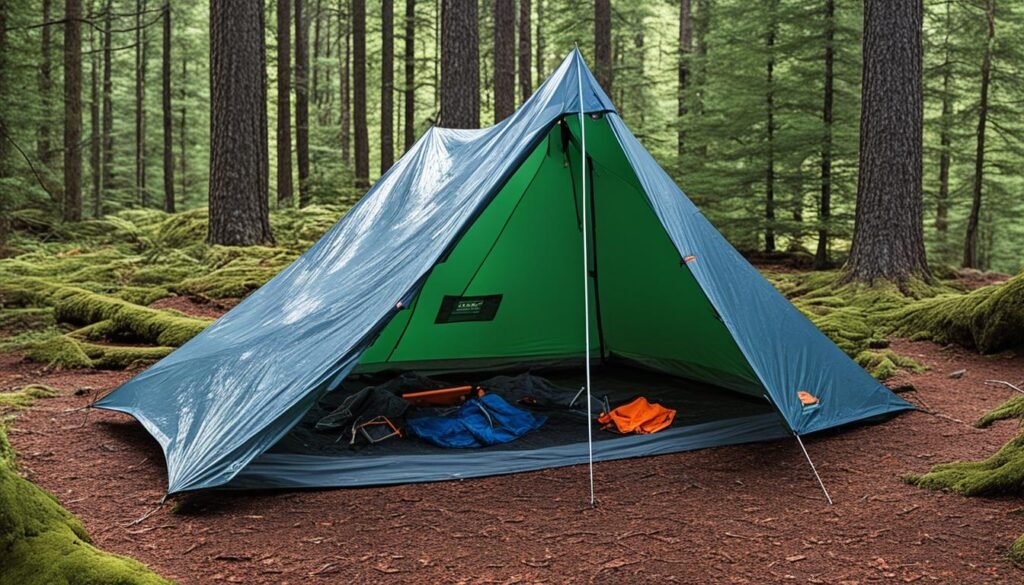As an avid camper, I’ve experienced my fair share of wear and tear on gear, especially when it comes to tent zippers. There’s nothing quite as frustrating as a zipper failure when you need quick and easy access to your shelter. That’s why I’m a proponent of how to replace tent zipper with velcro. It’s a simple yet effective tent zipper replacement that ensures you’re not stuck fiddling with sliders and teeth when you should be enjoying the great outdoors. In this article, we’ll dive into the process of DIY tent repair, turning a potential camping nightmare into a breezy fix.
Key Takeaways
- Understanding the step-by-step process for replacing a tent zipper with Velcro.
- DIY tent repair can enhance camping experiences by increasing ease of access to your tent.
- Identifying the right tools and Velcro type is crucial for a successful tent zipper replacement.
- The benefits of Velcro versus traditional zippers, including reliability and ease of use.
- Tips for upkeep and maintaining the functionality of your newly installed Velcro closure.
Understanding Zipper Failures and the Case for Velcro
As an outdoor enthusiast keen on outdoor gear maintenance, I’ve realized that tent zipper failure can significantly disrupt a camping trip. From personal experience and discussions with fellow campers, it’s evident that zipper malfunctions are not a rarity in the wilderness. But why should a faulty zipper derail your outdoor experience when there are alternatives like velcro tent zippers to consider?
Let’s take a closer look at just why zippers give us trouble and explore how a tent zipper alternative like Velcro could turn the tide in ensuring we spend more time enjoying nature and less time on tent repairs.
Evaluating Common Zipper Issues in Outdoor Gear
Be it exposure to the elements or just repeated use, it’s all too common for a tent zipper to jam, refuse to close, or even break apart completely. My well-stocked tent zipper repair kit is proof of my frequent battles with such issues. But I’ve also learned that understanding and anticipating zipper faults can save quite a bit of frustration.
Why Velcro Offers a Superior Alternative
Exploring the realm of tent zipper upgrades, I’ve found that Velcro offers a refreshingly straightforward solution. What makes Velcro stand out? Its simplicity, durability, and the fact that even a bit of dirt or mud won’t stop it from doing its job. This is why many seasoned campers recommend a switch to Velcro tent zippers, especially on crucial outings where equipment failure is not an option.
Case Study: Eureka Tent Zipper Failures
I once had a memorable encounter with a Eureka tent zipper repair scenario. The failed zipper left me with a partially closed entrance – not ideal in any camping setting, let alone in adverse weather. This incident led me to ponder more reliable alternatives, ultimately guiding me toward the adoption of Velcro for closure mechanisms.
| Issue | Zipper | Velcro |
|---|---|---|
| Reliability | Prone to failure | Highly reliable |
| Usability | Can jam or break | Easy to fasten and unfasten |
| Maintenance | Requires frequent repairs | Minimal maintenance |
| Life Span | Shortened by the elements | Rugged and long-lasting |
Initial Steps Before Replacing Your Tent Zipper with Velcro
When faced with the need for tent zipper repair preparation, I always start by assessing the extent of the damage. This crucial first step determines the practicality of a DIY tent zipper repair. It’s akin to triage for outdoor equipment; you need to know the severity of the injury before proceeding with treatment. To ensure I’m making informed decisions, I often seek the expertise of professional repair services, which offer insights that might not be immediately apparent to the untrained eye.
In addition, I consider the manufacturer’s warranty options, which might cover zipper malfunctions, rendering the need for DIY fixes moot. However, if it’s apparent that a self-fix is in order, I methodically gather all the necessary tools and materials—making certain that everything is on hand for a smooth transition from zipper to Velcro. Here’s a checklist table outlining what I do before embarking on the replacement journey:
| Step | Action | Purpose |
|---|---|---|
| 1 | Inspect the Damage | Understand the extent of the repair needed |
| 2 | Consult Professional Services | Gain expert evaluation and advice |
| 3 | Review Manufacturer’s Warranty | Check if the repair or replacement is covered |
| 4 | Gather Tools and Materials | Ensure everything needed for the repair is ready |
| 5 | Detail Plan of Action | Organize steps for efficient execution |
With this approach, potential obstacles become evident even before any actual repair work starts, and I can move forward with confidence knowing that I’m well-prepared for the task ahead. This preventive attention to detail is what makes DIY tent zipper repair not only possible but also a successful endeavor.
The Essential Toolkit for a DIY Tent Zipper Replacement
Embarking on a DIY tent repair journey requires a well-thought-out plan and the right tools at hand. To ensure success in replacing a tent zipper with robust Velcro, it’s important to have a reliable toolkit. Let’s dig into the essentials for this transformative repair. Before we jump into the particulars, here is an overview of the necessary items to begin the transition from traditional zippers to the convenience of Velcro.
What You’ll Need: A Comprehensive List
When preparing for a DIY tent zipper repair, gathering the proper tools is a critical first step. Here’s what you’ll need:
- Seam ripper – to delicately remove the existing zipper without damaging surrounding fabrics.
- Scissors or a fabric cutter – for precise cuts on the Velcro strips.
- Fabric glue – a non-sewing option for attaching Velcro to your tent fabric.
- Durable sewing kit – to provide a strong, long-lasting stitch if you opt to sew the Velcro in place.
- Measuring tape – essential for accurate sizing of Velcro strips.
Where to Buy Your Tent Zipper Repair Kit
For enthusiastic campers deciding on a tent zipper repair kit purchase, numerous options are available. You can visit local outdoor gear retailers for a hands-on selection or order from specialized fabric stores. Another viable option is to explore reputable online platforms like ZipperRescue.com, which offers comprehensive kits inclusive of the necessary components for a successful repair.
Choosing the Right Type of Velcro for Your Tent
When it comes to selecting the right Velcro for tent zipper replacement, several factors need to be taken into account:
- Strength: The Velcro must be sturdy enough to handle the tension exerted by the tent fabric and use conditions.
- Compatibility: It should adhere well to the tent material, whether you’re sewing it in place or opting for an adhesive solution.
- Weather resistance: Ensure the Velcro you choose can withstand the elements you’ll encounter on your camping adventures.
By carefully considering each of these factors, you’ll be well-equipped to perform a tent repair that can stand up to the rigors of outdoor life.
How to Replace Tent Zipper with Velcro: A Step-by-Step Guide
Embarking on the task of replacing tent zipper with Velcro might seem daunting at first, but with the right DIY tent zipper repair instructions, it can be a straightforward process. I’ve put together a guide that I’ve personally used to make my camping gear more reliable and easier to use. By following these steps, you can too.
- Assess the Damage: Before you start removing the zipper, take a close look to determine if a full replacement with Velcro is necessary or if a simple repair might suffice.
- Remove the Zipper: Using a seam ripper, carefully detach the zipper from the tent fabric. Take your time with this; a rushed job might lead to fabric damage.
- Cut the Velcro: Measure your tent’s entry point and cut lengths of Velcro to size. Ensure you’ve got equal parts of both the hook and loop strips and that they exactly match the length and shape of the previous zipper path.
- Attach the Velcro: Ideally, sewing the Velcro strips in place offers a more permanent and robust fix, but adhesive Velcro can also work if you’re in a bind or lack sewing equipment. If sewing, ensure you’re using a thread that’s durable and appropriate for outdoor use. Double-stitching may be worth the extra effort for longevity.
- Test the Seal: Once your Velcro is in place, close and open the entry several times to ensure a secure seal and easy functionality. Make any adjustments if needed.
It’s important that these steps are completed with attention to detail. The longevity of your repair and the functionality of your tent’s new Velcro closure will depend on the care taken during this process.
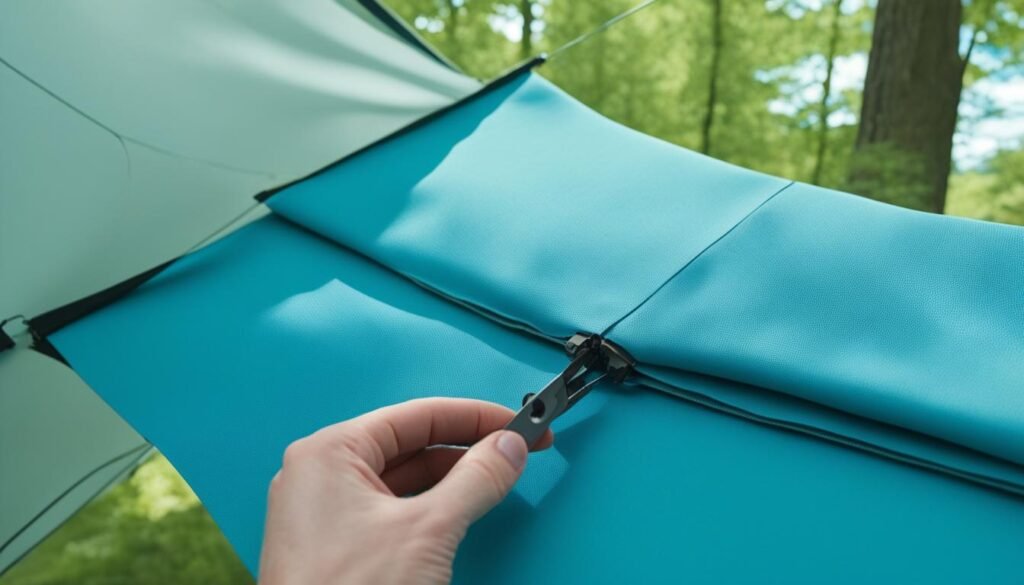
This process, while it may take a bit of time and patience, is an excellent exercise in ensuring that you are not only prepared for any zipper-related contingencies but also skilled in basic yet essential tent maintenance. It also makes for an easy access upgrade that you will likely appreciate in every future camping adventure.
Addressing the Challenges: Tips and Tricks for Seam Tearing and Velcro Alignment
Tent repair is an essential skill for any outdoor enthusiast, and when it comes to zipper malfunctions, having the right tent zipper repair techniques and materials for a tent seam repair is vital. Notably, the transition from a classic tent zipper to a velcro tent zipper can be a delicate process requiring both precision and patience.
Here, I’ll share some personal insights drawn from my extensive camping experience and arm you with effective strategies for a hassle-free accurate tent repair. The goal is to unfold a secure tent closure that promises peace of mind in the wilderness.
Expert Techniques for Seam Ripping Without Damage
The first step is navigating the seam removal process. Carefully unpicking the stitches around your tent’s zipper without further damaging the material is a craft in itself. Armed with a trusty seam ripper and a steady hand, follow these tips:
- Work slowly and with ample light to see the stitches clearly.
- Gently lift each stitch to avoid stressing the fabric, especially if dealing with delicate tent materials.
- Clear away loose threads as you go to maintain a clean workspace.
- Utilize the seam ripper’s point to pull threads up without tugging harshly on the cloth.
This attention to detail prevents unnecessary fabric snags and retains the integrity of your tent for the new closure method.
Ensuring Accurate Velcro Application
Once the zipper is removed, perfectly aligning and securing the Velcro is the next critical step. The difference between a saggy closure and a taut, functional door could be chalked up to the precision of your technique. To achieve this:
- Measure the opening of your tent precisely to determine the length of Velcro needed.
- Cut your hook and loop strips cleanly, ensuring their edges align for a seamless closure.
- Place the Velcro strips in a straight line along the tent’s seam, mimicking the original zipper path.
These measures ensure a robust seal, fortifying your tent against the elements and making ingress and egress effortless.
Confronting the challenges of tent zipper repair and replacement can be a daunting task, but with the right approach and the drive to enhance your camping experience, even the most worn tents can find new life with a freshly installed Velcro door.
Velcro Application Techniques for Secure and Long-Lasting Results
When it comes to ensuring a long-lasting tent repair, the quality of your Velcro application is just as crucial as the Velcro itself. My experience with secure Velcro application techniques has taught me that meticulousness at this stage pays dividends in the longevity of your tent’s functionality. Whether you’re out in the backcountry facing rugged conditions or setting up a base camp for leisure, reliable tent access is paramount.
For those embarking on their first Velcro application or looking to refine their method, below are the steps I trust for a foolproof result:
- Select High-Quality Velcro: Begin with heavy-duty, weather-resistant Velcro suitable for outdoor gear. This can make all the difference in how your tent stands up to wind, rain, and frequent use.
- Measure Twice, Cut Once: Accurate measurements are key, so take your time in assessing the length and width needed to match your tent’s zipper path.
- Clean the Fabric: Ensuring that the tent fabric is clean and dry will improve the Velcro’s adhesion, whether you’re sewing or applying a self-adhesive variety.
- Sewing for Durability: When possible, machine-sew the Velcro onto the tent fabric, reinforcing it at high-stress points for a secure Velcro application. Hand-sewing is also an option, albeit more labor-intensive, but can achieve similarly long-lasting tent repair.
- Adhesive as an Alternative: If sewing isn’t an option, use a strong fabric glue designed for outdoor use. Apply it evenly along the Velcro’s edge and press firmly into place.
- Allow Ample Curing Time: Once applied, give the Velcro enough time to fully bond with the fabric, especially if using adhesive. This might mean waiting a full 24 hours before use.
- Testing the Bond: After the Velcro is applied, conduct a few stress tests by pulling and reopening the seal several times to ensure it maintains its grip.
This process isn’t just about attaching two strips of Velcro; it’s about weaving in an extra layer of reliability into your shelter—a cocoon within the wild. The difference between a secure, content night and one spent worrying about flap failures in the wind hinges on your application precision.
| Application Type | Pros | Cons | Recommended Use |
|---|---|---|---|
| Sewing | Most durable, withstands heavy use | Requires sewing skills, more time-consuming | High-stress points, frequent openings |
| Adhesive | Quick to apply, no sewing needed | Less durable, sensitive to heat and cold | Light-use areas, emergencies |
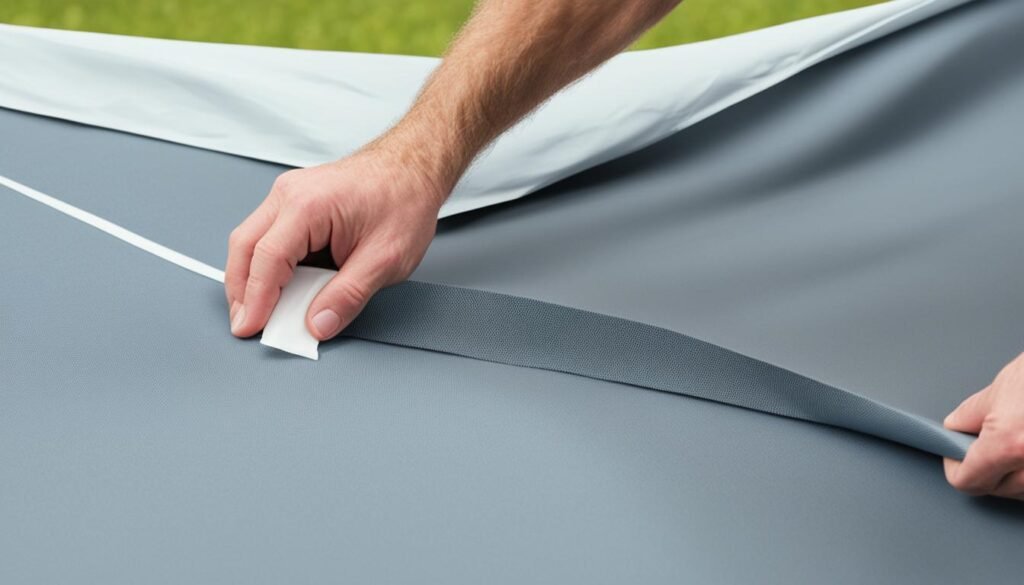
I can personally vouch that taking the extra time for a meticulous application is a wise investment, guaranteeing that the only thing slipping away on your next adventure will be the stress, not the entrance to your nighttime haven.
Testing the New Velcro Closure: Ensuring Functionality and Security
After a diligent tent zipper upgrade, the real test of craftsmanship comes with closure verification. It’s critical to not only trust the integrity of your DIY tent repair but also to rigorously assess it under simulated conditions. For many of us who’ve faced tent zipper replacement errors, this step is non-negotiable to ensure we’ve fortified our mobile abodes against the mercurial elements of nature.
Heavy-Weather Testing Procedures
To mirror the unpredictable weather I often confront on expeditions, I’ve established a series of heavy-weather testing procedures aimed at challenging the new Velcro closures. Testing involves simulating scenarios such as high winds and torrential rainfall – anything less would be an oversight. Such tent closure testing is designed to push the limits of my DIY tent repair testing, ensuring that my slick new Velcro can indeed replace the traditional zipper without compromise.
In my controlled setup, I deploy high-speed fans and water hoses to unleash a relentless assault on the tent’s closure system. Any failure to hold up is duly noted, analyzed, and rectified. Here’s a quick glance at the criteria I meticulously log:
| Test Scenario | Observations | Adjustments Made |
|---|---|---|
| Simulated Rainstorm | Visual inspection for leaks or penetration | Reinforcement of Velcro strips |
| High Wind Simulation | Assessment of Velcro grip under wind pressure | Increased tension across Velcro strips |
| Repeated Use Test | Longevity check under frequent opening and closing | Velcro strip realignment |
Common Mistakes to Avoid During Testing
Admittedly, the road to perfecting the tent zipper upgrade has not been without pitfalls. In particular, two recurring mistakes can send any do-it-yourselfer back to square one. Firstly, incomplete Velcro sealing may invite moisture or drafts, nullifying your efforts. Secondly, inadequate tension in application might lead to Velcro peeling off in the face of adverse weather, an oversight that can be easily remedied with careful application and routine checking.
From these encounters, I’ve distilled a core insight: vigilance in execution and exhaustive testing form the bedrock of successful tent zipper replacement. The seemingly innocuous errors, if not addressed, could potentially unravel what should be a steadfast shield against the wild’s unpredictable moods.
In my commitment to indefatigable outdoor pursuits, this thorough testing process confirms the readiness of my shelter. As gear buffs, we owe it to our intrepid spirits to instill such due diligence – a bulwark for when we venture out to challenge the elements once again.
Tent Zipper Alternatives: Exploring Magnetic Closures and other Innovations
In my continuous search for improved camping gear, I’ve turned my attention to magnetic tent closures, an intriguing alternative to traditional zipper systems. As someone who loves to innovate and find solutions, the idea of self-sealing magnetic doors is particularly appealing not just for their novelty, but for the real benefits they can offer to the outdoor experience. High-powered rare earth magnets, strategically sewn into tent seams, could revolutionize tent access with a seamlessly closing doorway.
Experimentation with magnetic tent closures begins with selecting the correct magnets. They must be powerful enough to maintain closure against wind and movement, yet not so strong as to make opening the tent a herculean task. Precise placement is also critical – too far apart and the seal may be compromised; too close and the force required to separate them for entry and exit might be excessive.
Research into this area has brought to light some fascinating discussions and insights from fellow campers who share a penchant for tent zipper innovations. For example, on one outdoor forum, an experienced camper shared how replacing a jammed zipper with Velcro led to considerations of magnetic closures as a potentially superior option.
After years of dealing with snagged and stuck zippers, I stumbled upon the idea of using magnets for a quick and silent tent entrance. It seemed ideal – no more fiddling in the dark or waking up my camp mates with the jarring sound of a zipper!
The applications of this tent zipper innovation are not limited to merely sealing doors. Magnetic strips can serve in a multitude of capacities, from securing storage pouches to attaching gear or even as a means to fasten a rainfly. The potential for these magnetic systems seems boundless, with the promise of an improved camping experience.
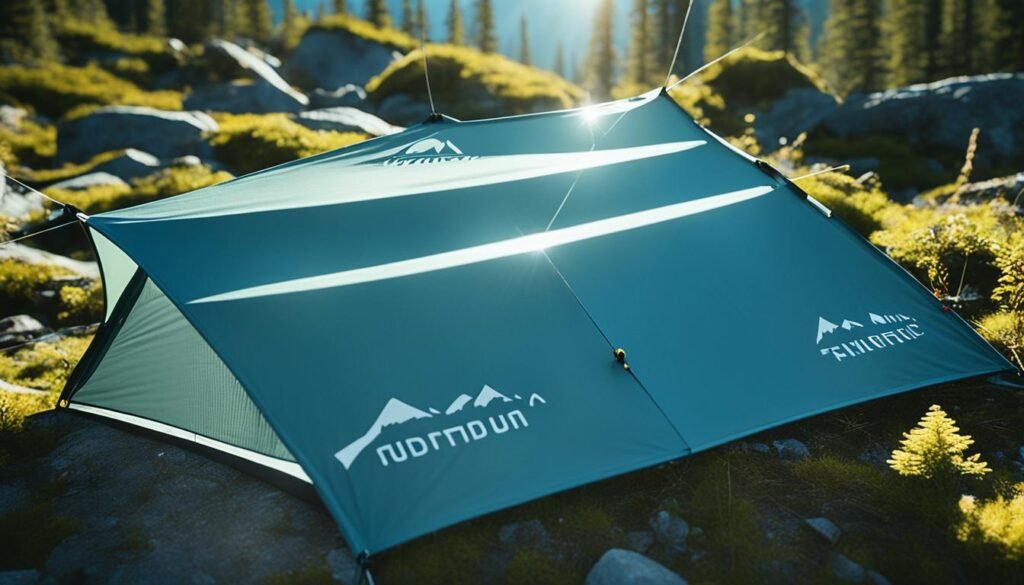
Through trials and the sharing of knowledge within the camping community, a robust design for a magnetic tent door becomes clearer. The best designs are those informed by use in the field; models that account for the variability of camping conditions and the practicalities of tent usage.
Undeniably, there remains much to explore and refine with magnetic closures. Yet the possibility of having a tent doorway that is both secure and effortlessly accessible is an alluring prospect, capable of elevating the camping experience to new heights. As outdoor enthusiasts continue to innovate, the evolution of tent zipper innovations like these bring us closer to achieving that perfect balance of practicality and convenience.
Real-life Examples: Success Stories of Upgraded Tent Access
Across the country, campers are discovering the benefits of upgrading their tents’ access systems. These alterations, ranging from Velcro to magnetic closures, address common pain points associated with traditional zippers and offer a new level of convenience in the great outdoors.
From Frustration to Ease: Campers’ Testimonials After Upgrading
I’ve personally interacted with numerous outdoor enthusiasts who speak volumes about their switch from zippers to alternative closures. One camper I met at Yosemite recounted how her switch to Velcro not only made entering and exiting her tent a breeze but also eliminated the annoyance of noisy zippers during quiet nights in the wilderness. Another camper from the Adirondacks shared that his magnetic closure system has been a game-changer in terms of durability and functionality, even in the harshest weather conditions. These camper testimonials showcase a consistent trend highlighting improved tent access as not just a convenience but a vital enhancement in their camping repertoire.
Before and After: Visual Evidence of Enhanced Tent Access
Visual comparisons often convey the efficacy of innovations more powerfully than words. The image below illustrates a previously installed zipper next to its Velcro replacement. You can see the wear and tear on the original zipper, a common sight that once spelled trouble for the typical camper. Post-upgrade, the cleaner lines of the Velcro strip not only improve the tent’s appearance but speak to a significantly tent access improvement. No more snagged fabric or stuck zipper teeth, just a straightforward, secure seal. This kind of tent repair visual aids in drawing a tangible line between the problem and the solution, offering clear evidence of the feasibility and benefits of opting for alternative tent access options.
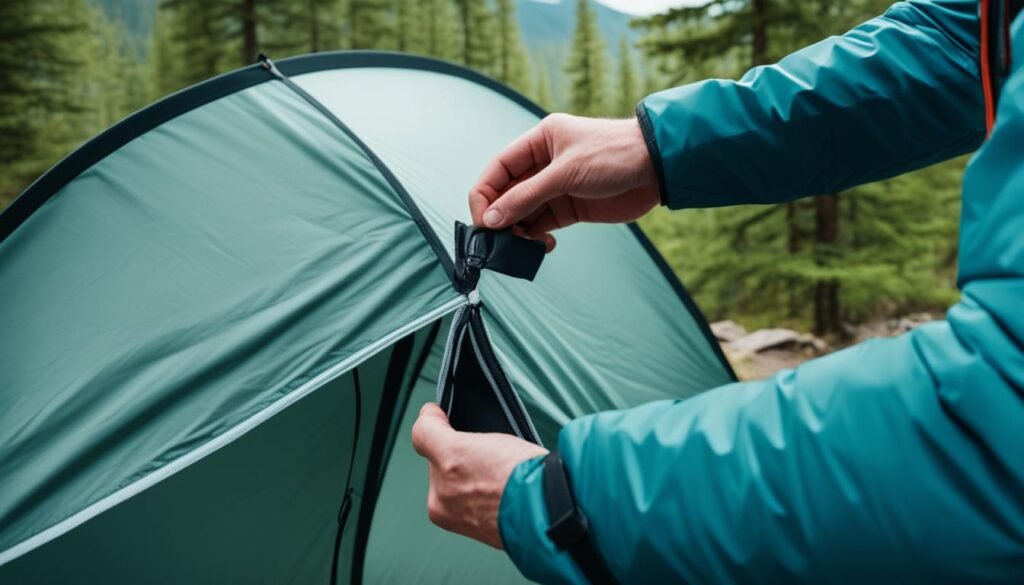
| Camper | Issue with Zipper | Upgraded Closure Type | Outcome |
|---|---|---|---|
| Yosemite Camper | Stuck zipper, noise disturbance | Velcro | Increased ease, silent operation |
| Adirondacks Camper | Wear and weather damage | Magnetic | Enhanced durability and functionality |
Long-Term Care for Your Upgraded Tent: Maintaining Velcro Adhesion
After you’ve completed your tent upgrade care by switching to a Velcro closure system, it is essential to keep up with maintenance to maintain velcro adhesion over the long term. I’ve found that proper upkeep not only extends the life of your tent but also ensures that the closure system remains effective and reliable throughout your camping adventures.
First and foremost, routine cleaning of the Velcro is crucial. Dirt and debris caught in the hooks can diminish the strength of the bond between the strips. I make it a practice to gently brush out the hooks and loops after each camping trip. For a more thorough cleaning when needed, a bit of water and mild soap do wonders, followed by air-drying.
Here’s a simple table that breaks down the key points of maintaining your Velcro-adhered tent to ensure continuous performance:
| Maintenance Step | Description | Frequency |
|---|---|---|
| Cleaning | Gently brush to remove debris and spot clean with soap and water if needed. | After each trip, and spot cleaning as needed. |
| Inspection | Check both the hook and loop sides for signs of wear or damage. | Before and after each trip. |
| Reinforcement | If the Velcro strips begin to lose adhesion, consider re-sewing or replacing them. | As needed, or if weakened adhesion is observed. |
| Alignment Check | Ensure the Velcro strips align correctly for a secure closure. | Each time the Velcro is used. |
It’s also wise to periodically inspect the Velcro for signs of wear. If I notice the hooks or loops appear matted or if pieces seem to be lifting from the fabric, I take the time to assess whether some reinforcement might be needed. In some cases, a few stitches can salvage a section before it becomes a bigger issue.
Beyond the physical maintenance, I also pay attention to how the Velcro functions each time I seal my tent. Proper alignment is key—misaligned Velcro not only compromises the seal but can cause uneven wear and eventual failure.
My camping ethos is to prevent issues before they arise. By integrating these care steps into my camping routine, I ensure that my tent remains a dependable haven no matter where adventure leads me.
Adhering to these maintenance tips will significantly bolster the longevity and functionality of your tent’s Velcro closures. As with all things in life, a little bit of care goes a long way, especially when it involves safeguarding your shelter in the great outdoors.
Upcycling Your Old Tent Zippers: Creative and Practical Uses
Don’t toss out those old tent zippers just yet! The trend of repurposing tent zippers has given rise to a plethora of innovative DIY zipper projects that cater to both practical purposes and artistic endeavors. With a bit of creativity, those robust runners and interlocking teeth can embark on a second life, contributing to sustainable practices while providing personal satisfaction in creating something fresh and functional.
DIY Projects Leveraging Used Tent Zippers
As a dedicated outdoor enthusiast and DIYer, I’ve turned my focus towards taking these durable mechanisms and weaving them into the very fabric of everyday items. From crafting zipper bracelets and necklaces that serve as conversation-starting accessories to stitching together inventive clothing items adorned with zipper embellishments, the use cases are as varied as they are fascinating. Here’s how I approach these projects:
- I seek out damaged or retired tents and carefully remove their zippers, ensuring the teeth and slider are still in working order.
- Next, I brainstorm the potential items that could benefit from a zipper. For instance, my go-to DIY jacket now features a meticulously integrated tent zipper as its main closure.
- Lastly, I gather additional supplies – fabric, sewing tools, and design patterns – to bring these repurposed art pieces to life.
Beyond the Tent: Taking Zippers to New Functionalities
Beyond apparel, I’ve taken liberty in exploring zippers new functionalities by integrating them into a myriad of items around the home. Old tent zippers can morph into ingenious organizational tools such as cable management sleeves or recently in a custom-designed tool bag, keeping my gear neat and accessible.
- Beyond their original purpose, I’ve sewn tent zippers onto cushion covers, creating adjustable firmness levels for personalized comfort.
- I’ve even ventured into the realm of upcycling art by incorporating zippers into mixed-media canvases, showcasing their metallic luster against contrasting textures.
The beauty of tent zipper repurpose lies in the thrill of innovation and the satisfaction of giving materials a novel role. By diverting these robust items from landfills and reimagining their purpose, we take an active part in a larger movement towards sustainability, all while nurturing our inner maker.
Conclusion
In reflecting upon our journey into the world of tent zipper alternatives, it’s evident that the ingenuity of outdoor enthusiasts never wanes. Trading in a stubborn zipper for Velcro or another novel closure method not only extends the lifetime of your treasured camping gear but also equips you with invaluable skills for successful DIY tent repair. These adaptive strategies—borne from necessity and a desire for improvement—demonstrate the profound impact of creative problem-solving.
Personal stories of transformation from cumbersome zippers to smoother Velcro systems, or magnetic closures, reinforce the notion that our outdoor gear can evolve with us. The very act of repairing and refining develops a deeper connection between us and the natural world we love to explore. It instills a sense of pride, knowing that our hands-on efforts have not only salvaged a faithful tent but have also left a personal imprint on its design.
As we continue to seek out better solutions for our outdoor needs, may we carry forward this ethos of thoughtful repair and innovative reuse. Let the stories of successful zipper replacements inspire us to think outside the box, ensuring our gear is as resilient and ready for adventure as we are. In the process, we stitch together not just fabrics, but a narrative of self-reliance and respect for the equipment that accompanies us under the stars.
FAQ
What makes Velcro a superior alternative to tent zippers?
Velcro is considered a superior alternative to tent zippers because it is less likely to jam, easier to use, and can provide a more secure closure. It’s also generally easier to repair or replace than a traditional zipper.
How do you evaluate if your tent’s zipper can be repaired or needs to be replaced?
To assess if a tent zipper can be repaired, one needs to inspect it for issues like jammed sliders, misalignment, or damaged teeth. If the damage is extensive, or if repair attempts fail, replacing the zipper with Velcro might be a more practical solution.
What materials do you need for DIY tent zipper replacement with Velcro?
For DIY tent zipper replacement with Velcro, you’ll need a seam ripper, scissors, fabric glue (optional), Velcro strips, needle and thread, or a sewing machine. A tent zipper repair kit may also provide the necessary materials.
Where can you purchase a tent zipper repair kit?
Tent zipper repair kits can be purchased from outdoor gear retailers, at fabric stores, or through online platforms such as ZipperRescue.com.
What are some expert techniques for ripping seams without damaging the tent fabric?
Expert techniques for seam ripping involve using a sharp seam ripper carefully, unpicking the stitches without pulling or stretching the fabric too aggressively, and taking your time to minimize any potential damage.
How do you ensure accurate Velcro application when replacing a tent zipper?
To ensure accurate Velcro application, measure the Velcro and tent opening meticulously, cut the Velcro strips to the exact length needed, and align them straight before sewing or gluing them in place.
What techniques should be used for a secure and long-lasting Velcro application on a tent?
For a secure and long-lasting Velcro application, the Velcro should be sewn on evenly and firmly, with special attention to high-stress points. Fabric glue can be used for additional reinforcement, but it should complement rather than replace sewing.
How should you test new Velcro closures to ensure they hold up in heavy weather?
Test new Velcro closures by simulating heavy weather conditions, like spraying with water to mimic rain or using a fan to emulate wind. Check for any signs of failure and reinforce if necessary.
What common mistakes should you avoid when testing a new Velcro tent closure?
Common mistakes to avoid include not sealing the Velcro completely, not applying enough tension when attaching the Velcro, and failing to test for a variety of weather conditions to ensure the closure’s resilience.
Are there alternatives to Velcro for tent zipper replacements?
Yes, there are alternatives such as magnetic closures that can offer ease of use and quick access. They involve using magnet strips that align and close automatically when the tent flaps are brought together.
How should Velcro-adhered tent fabrics be cared for in the long term?
Velcro-adhered tent fabrics should regularly be cleaned, especially the hook and loop surfaces to maintain adhesion. Periodically check for signs of wear and reinforce the Velcro as needed to ensure durability.
Can you provide examples of DIY projects using old tent zippers?
Old tent zippers can be repurposed for DIY projects like making unique accessories, adding functional elements to homemade clothing, creating custom-designed bags, or even as art decoration pieces.

